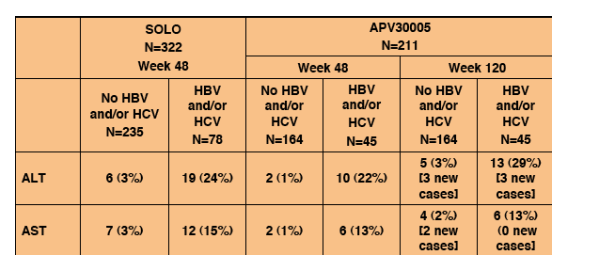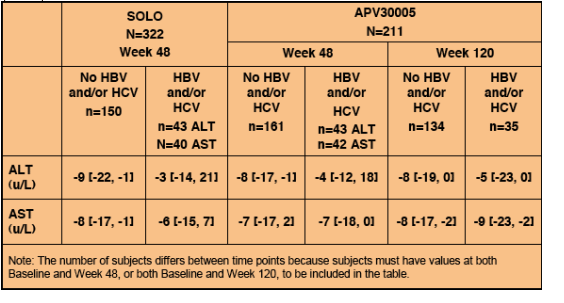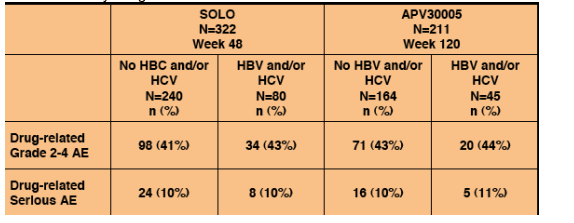 |
 |
 |
| |
Fosamprenavir ALT Changes, AEs: SOLO Study
|
| |
| |
Reported by Jules Levin
3rd IAS Conference
July 24-27, 2005
Rio de Janeiro
Poster Number TuPe1.1C03
Edwin DeJesus1, Andrzej Gladysz2, Jose Vera3, Federico Pulido4, Giampiero Carosi5, Cindy Garris6, Naomi Givens7, Jane Yeo7, Mark Felton7
1Orlando Immunology Center, Orlando, Florida, USA; 2Wroclaw University School of Medicine, Wroclaw, Poland; 3Centro Hospitalar de Cascais, Cascais, Portugal;
4Hospital Universitario Doce de Octubre, Madrid, Spain; 5Clinica di Malattie Infettive e Tropicali, Brescia, Italy; GlaxoSmithKline R&D, 6RTP, USA; 7Greenford, UK
Study authors summarized:
--An earlier analysis through Week 48 of the randomised phase of SOLO (5) had demonstrated that both FPV and NFV containing HAART had a favourable effect with a modest reduction in median ALT and AST levels in both HBV/HCV co-infected and non coinfected patients. By Week 48 approximately 20-25% of coinfected subjects in both the FPV and NFV arms experienced grade 3/4 elevations in ALT and AST (mostly ALT). It was suggested that some of these elevations might be due to the natural history of hepatitis infection or to immune reconstitution leading to HBV immune mediated response with ALT flares.
--The present analysis through 120 weeks shows that the favourable median change from baseline in ALT and AST observed at Week 48 was maintained. New Grade 3/4 ALT and AST elevations after Week 48 were relatively rare, being observed in less than 7% (3/45) of co-infected subjects compared to 3% (5/164) in non co-infected subjects. There were no differences in the incidence
of reported drug-related Grade 2-4 AEs or SAEs between the co-infected and non co-infected subjects through Week 120.
Table 4. Treatment Emergent Grade 3/4 ALT/AST
At week 48 in SOLO, 19/78 (24%) of patients receiving Fosamprenavir/r (1400/200) once daily had treatment emergent grade 3-4 ALT. Three co-infected subjects experienced a new treatment-emergent Grade 3/4 ALT elevation after Week 48. No co-infected subjects experienced a new treatment-emergent Grade 3-4 AST elevation after Week 48.

Table 2. Median [IQR] Baseline ALT and AST Values
As expected, median Baseline ALT and AST levels were higher in co-infected
subjects than in those without co-infection (Table 2). Median ALT was 41 u/L in coinfected & 26 in non-coinfected. Of the co-infected subjects, 18/43 (42%) and 12/43 (28%), respectively, had a Grade 1/2 ALT or AST toxicity at baseline. Of the non co-infected subjects, 32/161 (20%) and 25/161 (16%), respectively, had a Grade 1/2 ALT or AST toxicity at Baseline. Additionally, one non co-infected subject had a Grade 3 AST at Baseline. (ED NOTE: although 28-42% of coinfected patients had baseline ALT/AST elevations between 54-215 u/L, the poster did not report an analysis assessing a correlation between treatment-emergent grade3-4 ALT/AST and baseline ALT/AST elevations.

Table 3. Median Change from Baseline [IQR] in ALT and
AST (U/L)
At week 48 coinfected patients has a median decrease in ALT/AST of -3 and -8, respectively. Subjects in both the co-infected and non co-infected groups who completed at least 120 weeks had a median decrease in ALT and AST (Table 3).
Median change from baseline [IQR] results at Week 120 were similar using a
Last Observation Carried Forward (LOCF) analysis:
ALT: -7 [-19, 0] U/L for non co-infected (n=164); -4 [-20, 5] U/L for coinfected (n=45).
AST: -8 [-17, -3] U/L for non co-infected (n=164); -9 [-23, -2] U/L for coinfected
(n=45).

Table 5. Adverse Events
Over 48 and 120 weeks, similar proportions of co-infected subjects and non
co-infected subjects reported a drug related Grade 2-4 AE or drug related
Serious AE (Table 5). The most common drug-related Grade 2-4 AEs in APV30005, excluding hypersensitivity to abacavir, were diarrhea (18/164, 11%), increased triglycerides (13/164, 8%), and nausea (10/164, 6%) in non co-infected
subjects and nausea (6/45 13%), increased ALT (4/45, 9%), diarrhea (4/45,
9%), and vomiting (4/45, 9%) in co-infected subjects. One subject who was HBV and HCV negative at baseline prematurely discontinued FPV/RTV QD (approx. Week 68) due to a Grade 3 ALT which was considered by the investigator to be related to study drug.

INTRODUCTION
The interactions between hepatitis viruses and HIV are complex and clinically
important. Co-infection with HIV has been associated with accelerated HCV related liver damage and progression to end stage liver disease. Similarly, HBV
DNA levels are higher in HIV-infected patients and HIV increases the risk of
HBV-associated morbidity and mortality. Although antiretroviral therapy (ART) is
beneficial for HBV and/or HCV co-infected subjects, active hepatitis increases
their risk for ART-associated hepatotoxicity. Consequently, there is a need to
understand how individual ARTs perform in co-infected patients.
Fosamprenavir (FPV) is a protease inhibitor approved in the US (Lexiva),
Europe (Telzir), and other countries. FPV has been studied in clinical trials as
once daily (QD) dosing boosted with ritonavir (RTV), or twice daily (BID) dosing
with or without RTV. The efficacy and tolerability of FPV have been previously
demonstrated in ART-naive subjects (1,2). The objective of the analyses
described here was to assess liver enzyme changes over 120 weeks of treatment with ritonavir boosted FPV (FPV/r) QD in HIV-1 infected ART naive adults with HBV and/or HCV co-infection.
METHODS
322 HIV-1 infected therapy-naive adults received FPV/r 1400mg/200mg QD
and ABC+3TC BID in study APV30002 (The SOLO Study). Of those, 211
subjects completed ≥48 weeks and continued the regimen in rollover study
APV30005.
v
Subjects with co-infection were allowed to enroll in SOLO if their HBV/ HCV
infection was not clinically relevant within the last 6 months. Additionally, all
patients must have had ALT and AST levels below Grade 3 (<5 x ULN) within
28 days prior to FPV/r administration.
To assess liver enzyme changes in subjects with or without HBV (HBS Ag
positive) and/or HCV co-infection (anti-HCV positive), a review of ALT/ AST
laboratory values and AEs from Baseline to Week 120 in SOLO/APV30005
was conducted.
Toxicity grading for males [females] in U/L:
--ALT: Normal range: 6-43 [6-34]; Grade 1: 54-108 [43-85]; Grade 2:
109-215 [86-170]; Grade 3: 216-430 [171-340]; Grade 4: >430 [>340]
--AST: Normal range: 11-36 [9-34]; Grade 1: 45-90 [43-85]; Grade 2:
91-180 [86-170]; Grade 3: 181-360 [171-340]; Grade 4: >360 [>340]
References
1. Rodriguez-French A, Boghossian J, Gray GE, Nadler NP, Quinones AR, Sepulveda GE, et al. The NEAT study: a 48-week open-label study to compare the antiviral efficacy and safety of GW433908 versus nelfinavir in antiretroviral therapy-naive HIV-1-infected patients. J Acquir Immune Defic Syndr. 2004;
35:22-32.
2. Gathe JC Jr, Ive P, Wood R, Schurmann D, Bellow NC, DeJesus E, et al. SOLO: 48-week efficacy and safety comparison of once-daily fosamprenavir/ritonavir versus twice-daily nelfinavir in naive HIV-1-infected patients. AIDS. 2004; 18:1529-1537.
3. Alberti A, Clumeck N, Collins S, Gerlich W, Lundgren J, Palu G, et al. Short Statement of the First European Consensus Conference on the Treatment of Chronic Hepatitis B and C in Co-infected Patients. J Hepatology. 2005; 42: 615-624.
4. Pineda JA, Macias J. Progression of liver fibrosis in patients co-infected with hepatitis C virus and human immunodeficiency virus undergoing antiretroviral therapy. J Antimicrob Chemother, 2005; 55: 417-419.
5. Clumeck N, Fatkenheuer , Halota, Vera, Flamm, Stark, Sexton. ALT and AST Changes Over 48 Weeks in HIV-Infected Therapy-Naive Adults with Hepatitis B (HBV) and/or C (HCV) Coinfection Treated with 908/r QD. 9th European AIDS Conference (EACS), October 25-29, 2003, Warsaw, Poland. Poster 9.6/5.
|
|
| |
|
 |
 |
|
|